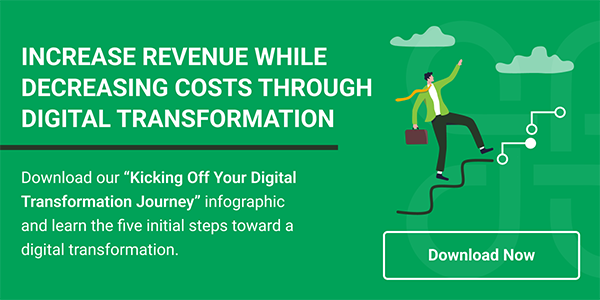Digital transformation offers the promise of improving efficiencies, creating value, and driving innovation. What that means for your organization is unique based on your goals and needs. Every enterprise will follow a path to digital transformation with three key components: technology, processes, and methodologies. Another common theme for all is the role of automation to support evolution and transformation.
Digital transformation is a changemaker for any business that wants to create, improve, or modify processes throughout the enterprise. While the path toward achieving digital transformation goals is difficult for every company, there are some proven steps to help any company get there.
In this post, we’ll review the primary steps of any digital transformation journey so you can successfully implement automation. True digital transformation can be elusive; a 2016 report found that 70 percent of transformation initiatives failed. You can avoid common pitfalls with these strategies and ensure your digital transformation investment delivers a return.
Identify Process Efficiency Gaps
You’ll start your digital transformation journey with this step. The goal is to map out your end-to-end processes and pinpoint the missing digitization experience within them. The only way to improve your inefficiencies is to first determine where they are.
Identifying process efficiency gaps can be overwhelming, so the first thing to consider is what approach you’ll take. Here are a few examples:
- Exploratory: In this approach, you’ll leverage Process Mining across specific areas to uncover the actual components of a process via transactional data.
- Confirmatory: With this method, you’ll address known gaps.
- Benchmarking: For this approach, you’ll compare your company’s standard processes to industry standards.
No matter the path you take, you may face challenges.
Challenges in Identifying Process Gaps and How to Overcome Them
Our experience with digital transformation journeys reveals major challenges that almost every organization will face:
- Resistance to change. Even good change is hard. People innately don’t like change, and getting them on board can be tough. Your best offense is to conduct “readiness” activities to evolve mindsets and overcome resistance.
- Defining the current state within a single business unit across various locations or regions. This can be difficult because of decentralization and variances. You can overcome these challenges by standardizing processes.
- Aligning process gap remediation with customer needs and expectations. Ensure the original business stakeholders are in regular communication with the solutioning team for end-user alignment.
Process efficiency gap discovery and improvement often focus on internal improvements, but you need to keep the customer in mind. You can do that by maintaining visibility on customer-focused metrics that matter, soliciting feedback from customers to gain insights and ask questions, and analyzing the customer experience your competitors provide.
Digital transformation comes with inherent risk implications. However, security and innovation aren’t foes; they can work together for the greater good. To create this environment, you’ll need to:
- Address security and risk management concerns head-on because avoiding them could create a situation in which IT steamrolls the plan at the last minute.
- Align digital transformation implementations with Change Advisory Board expectations and timelines.
- Conduct awareness and education sessions if your IT organization is new to digital transformation tools
Another consideration for this step is measuring the success of the process improvement initiatives. What metrics should you track? Here are a few core metrics to consider:
- Number of hours back to the business and the associated cost savings
- Labor metrics, including employee and contractor reductions, positions maintained, and hiring avoidance
- Business metric improvements: days sales outstanding (DSO), inventory reduction, and improved delivery metrics (e.g., turns, speed to customer)
- “Bot” implementations and utilization
- Engagement metrics
With this phase complete, you’ll move to step two.
Make Education Your Copilot
In this phase, your guide ensures education is a priority to inspire action and mitigate misinformation. Your first question would be whom to educate, and the answer is everyone across the company as appropriate. Accomplishing digital transformation involves maturing your automation program; you’ll need buy-in from executives across multiple business units. Their buy-in rolls downhill, and large programs should tie into strategic initiatives.
Countering misconceptions is crucial in this step. The most common misconceptions include:
- Digital transformation is easy. It’s not—however, it is well worth the effort.
- Selling digital transformation to employees is simple. In fact, it requires more effort than most realize.
- The workplace of the future will mean humans lose too many jobs to automation. The reality is that digital transformation and automation will eliminate some jobs in the future but will create many more. The better way to frame this concept is that it reimagines work, and you’re not streamlining a single process flow. It’s a fundamental change in interaction with the process and end users.
Education should also prepare and engage employees. Some tactics to facilitate this education include highlighting internal and external case studies and ideation sessions to promote readiness. Of course, it may not be easy to have people accept and absorb this information. Change is hard, and some will resist it or argue that they’re too busy.
Technology issues can also arise, so you must address these accordingly. Ensuring IT Is on board is imperative, but the business needs to lead while IT staff members provide support.
Use a Hub-and-Spoke Model
Stage three of your digital transformation journey is about working cross-functionally. The more departments you can represent, the better. You’ll also need to establish an automation Center of Excellence (CoE) to provide governance, stability, and communication.
When developing your CoE, focus on five pillars:
- Strategy and vision: Develop a forward-looking automation roadmap that aligns with your program’s goals and defines the measures of success.
- Governance: Establish a steering committee to deliver strategic guidance and decision-making. Outline a funding model and automation team structure, roles, and responsibilities.
- Operating model: Determine the operating model (centralized, hybrid, or federated) based on your organizational structure and automation program roadmap.
- People enablement: Evaluate the current skill sets and create a training roadmap to upskill the team.
- Digital workforce: Strategize how to maintain and integrate the digital workforce (bots) with the right level of monitoring capabilities.
- Innovation and change management: Develop and execute a change management strategy that considers people, processes, and technology for successfully adopting automation.
Building your CoE could come with challenges. Adequate engagement is often a concern, but you can address this by including stakeholders from many groups, not just IT. Developing your CoE also takes time because there are many practices to establish. A CoE can quickly go off track if you focus on the wrong things. Start with strategy and discovery, with an eye on automation deployments.
Measurement can also be problematic with or without a defined methodology. You’ll want to use maturity assessments and the same metrics associated with deployments.
The last critical component of this digital transformation journey step is achieving and maintaining executive buy-in and regularly reporting CoE progress to ensure alignment with business objectives.
Encourage a Culture of Ideation
In the fourth phase, you’ll turn your attention to ideation sessions. These events should showcase internal and external use cases because people respond better to visual and tangible examples than to anecdotes. In these meetings, you should also emphasize innovation in automation and how digital transformation promotes capabilities beyond Robotic Process Automation (RPA) with Artificial Intelligence and automation—all of which combine to form Intelligent Process Automation (IPA). To help with this, you might launch a citizen development program.
How else can you support ideation and facilitate brainstorming sessions?
- Employ a digital whiteboard for easier collaboration.
- Present use cases specific to each department.
- Hold interactive ideation sessions to get more people involved.
- Apply Process Mining to reveal all the components of a process and identify where automation can be of the most value.
- Use benchmarking data to track progress.
Also critical to this phase, as with all the others, is getting backing from leadership. They must consider IPA a strategic initiative and acknowledge that it is business-led and IT-supported.
These sessions will yield ideas, so you’ll want to establish criteria for what to pursue. Some guidelines could involve:
- Streamlining manual and repetitive tasks, such as data entry, with RPA. RPA can also help with multi-platform integration, high-volume actions, quality control or validation, and rule-driven business workflows.
- Setting a threshold of hours saved per year.
- Looking at high-value metrics, such as inventory reduction, customer experience, and shortened DSO.
Begin Your Digital Transformation Journey
You’ve done all the foundational work. Now it’s time to kick things off—almost. You’ll need to work through a few more items to officially launch.
First, you’ll need technology and tools. In determining which to select, you’ll want to define a decision point early and consider the timeline, support, and use case characteristics.
Second, you need to have checks and balances around your investment. To do so, track “value realized,” which translates to whether or not the solution yielded what you expected. Measure the actual value versus the expected value for each solution. You’ll also want to ask:
- Are the solutions consistently meeting the plan?
- Are you sunsetting too early?
- Will you realize net positives within a reasonable time frame?
- Are you concentrating on business units or expanding across them?
Third, remember that this journey isn’t about one-off solutions. It’s an enterprise-wide endeavor and should remain in alignment with company objectives that deliver a measurable impact to the business.
Fourth, continue to evolve and optimize your digital transformation strategy by integrating advanced technologies, measuring and improving, and expanding your footprint. The most critical thing to prepare for the journey reiterated through these phases is executive buy-in, which will help ensure these initiatives are recognized enterprise-wide.
Get more insights on kicking off your digital transformation journey by downloading our infographic featuring all five phases.



